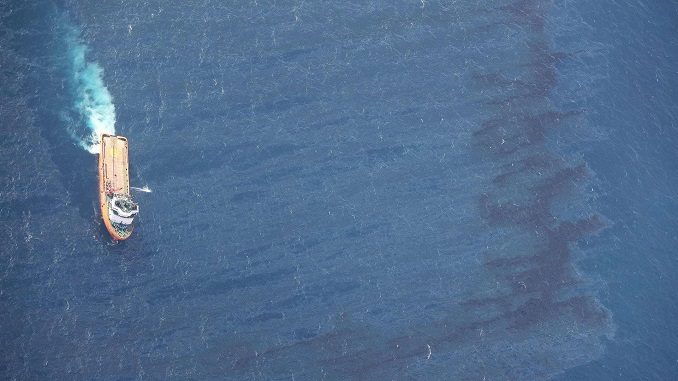
Iran appreciates China for its efforts to search the missing Iranian sailors aboard the oil tanker Sanchi, Iranian Minister of Labor, Cooperatives and Social Welfare Ali Rabiei has said as quoted by Xinhua. In a signed letter of thanks sent Wednesday to Chinese Ambassador to Iran Pang Sen, Rabiei said that China has made great efforts to rescue the crew aboard Sanchi and put out the fire on the tanker.
“As representative of the Iranian president and president of the Iranian investigation committee of the incident, I, in the name of the Iranian government and people, extend sincerest gratitude to the Chinese government and people, especially to the Chinese personnel who have risked their life to make every effort to rescue the tanker under the threat of toxic gas and explosion,” Rabiei said.
The Panama-registered oil tanker Sanchi, carrying 136,000 tonnes of light crude oil from Iran, collided with the CF Crystal, a Hong Kong-registered bulk freighter, about 300 km east of the Yangtze estuary on Jan. 6. Thirty-two crew members of the tanker — 30 Iranians and two Bangladeshis — were lost.
The minister regretted over the loss of crew members, saying that the support and humanitarian aid the Chinese government and people offered to Iran will be remembered forever by the Iranian people.
Oil from the Iranian tanker that sank in the East China Sea has diffused into four separate slicks, covering a combined area of just over 100 square km, Chinese authorites said late on Wednesday. Earlier satellite imaging showed two large slicks, with the larger one also thicker and more concentrated, but the latest data had found four slicks ranging in size from 48 square km to 5.5 square km, the State Oceanic Administration (SOA) said.
The SOA said in its statement late on Wednesday it had collected water samples from 19 spill sites, and found water from five sites had petroleum substances at levels exceeding standards. Clean-up teams were continuing to monitor the wreck area to assess the drift and diffusion of the oil spill and the ecological impact.
One of the slicks, about 18 km in length and 300 meters wide, was found about 11 km north of the sunken tanker, and another, about 20 km long and about 500 meters wide, was found 2 km southwest of the wreck, it said.
The oil spill from an Iranian oil tanker that sank in the East China Sea is now the size of Paris. The slick covers an area of 101 square kilometers, after almost doubling in size from the start of the week, according to figures released Wednesday by the Chinese State Oceanic Administration.
Chinese authorities said there were four separate slicks that had formed after the Panama-registered Sanchi tanker sank Sunday. The largest oil slick is 48 square kilometers, it added. The administration did not respond Thursday to a request for additional information.
Environmentalists and officials are worried the oil on board and fuel used to power the massive vessel could harm aquatic life for decades.
“The critical thing is to understand that when we put hydrocarbons into the oceans through events like this, it’s going to affect a wide range of animals,” said Jessica Meeuwig, a professor of biological sciences at the University of Western Australia.
The collision site was within the Zhoushan shipping ground, considered to be one of the richest fishing grounds in China, Ma Jun, one of China’s leading environmentalists said.
“If the oil spill is large, it could wipe out some fish species that are sensitive to the toxicity of the condensate. This is not what has been spilled in the past — it’s particularly unnerving because we don’t know what it will do to the environment. Sanchi might be one of the last straws before the ecosystem collapses,” Li Zhengyan, a professor with the college of environmental science and engineering at Ocean University of China in Qingdao, told the South China Morning Post.
Condensate, which is made up of a mixture of hydrocarbons, is lighter than the thick black crude oil associated with some of the world’s worst oil spills, such as the Exxon Valdez disaster. Then, 11 million gallons of crude oil poured into the ocean when the tanker ran aground off Alaska in 1989.
Condensate oil’s high volatility means it evaporates more easily than heavier crudes. Some of the oil on board the Sanchi — though it’s unclear how much — was likely consumed in the fiery blaze after the crash, environmentalists say. The giant oil tanker burned for over a week after it collided with a Hong Kong-registered freighter in the East China Sea, about 260 km from Shanghai. All 32 crewmembers aboard the Sanchi were killed, and only three bodies have been recovered. It finally sank on January 14, eight days after the collision.
The State Oceanic Administration is currently working to control the spread of the diesel oil by dousing it with chemicals, saying the slick is “being diffused and disappearing.”
